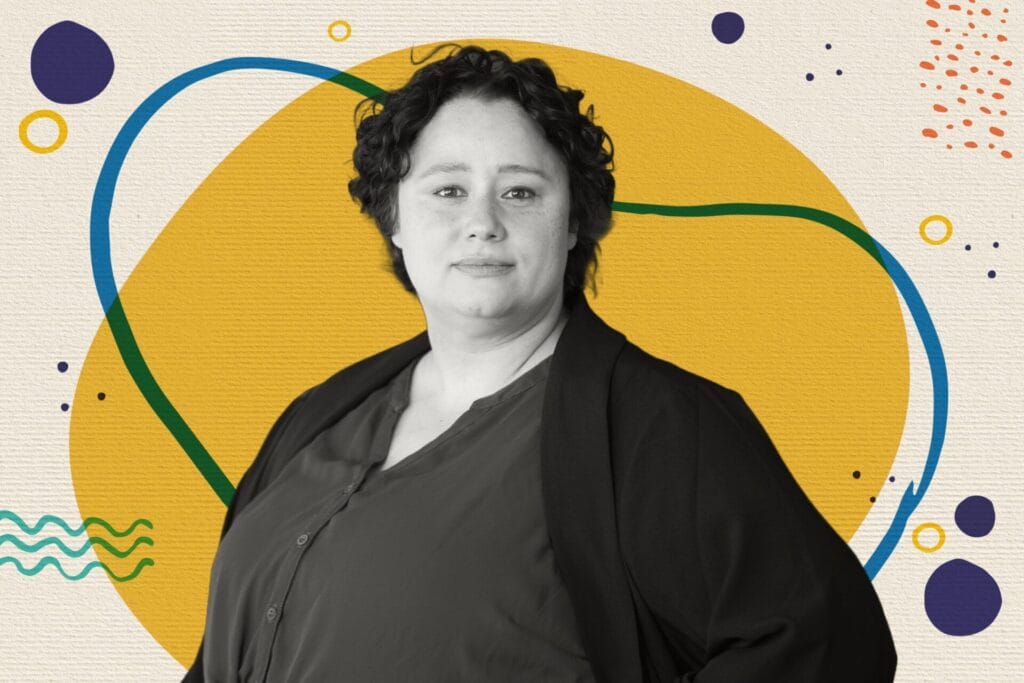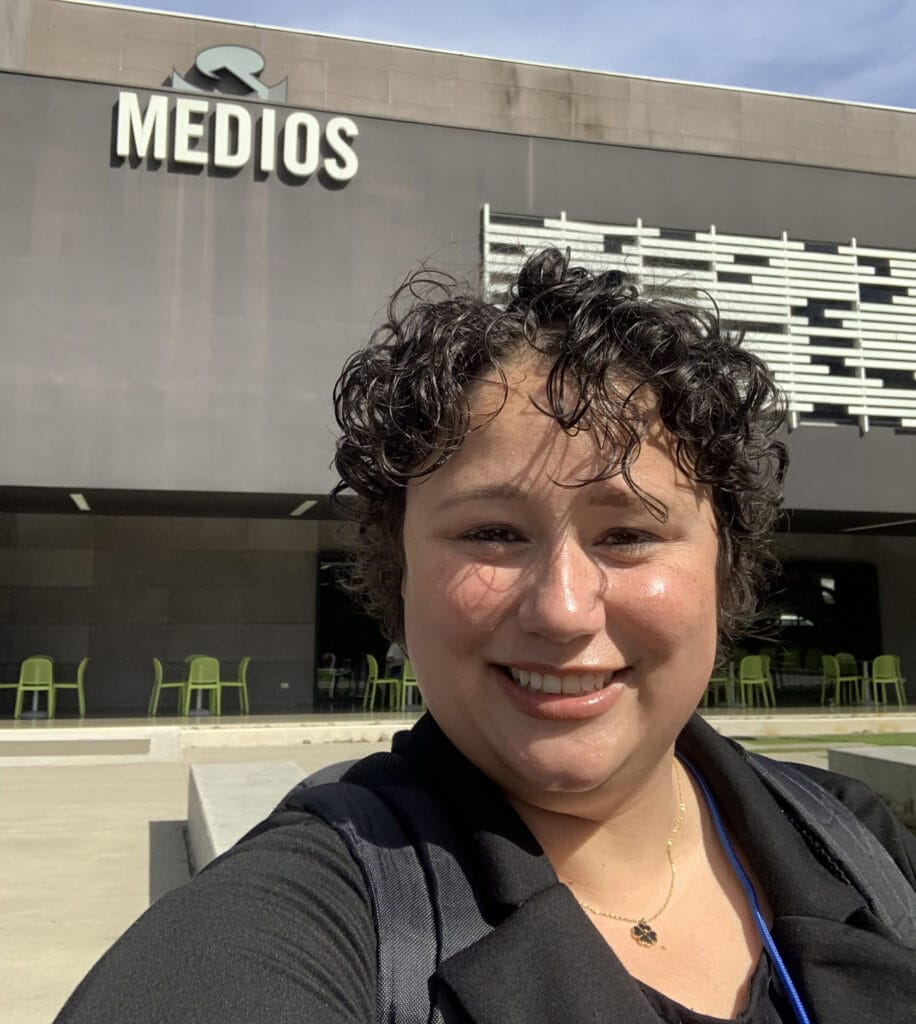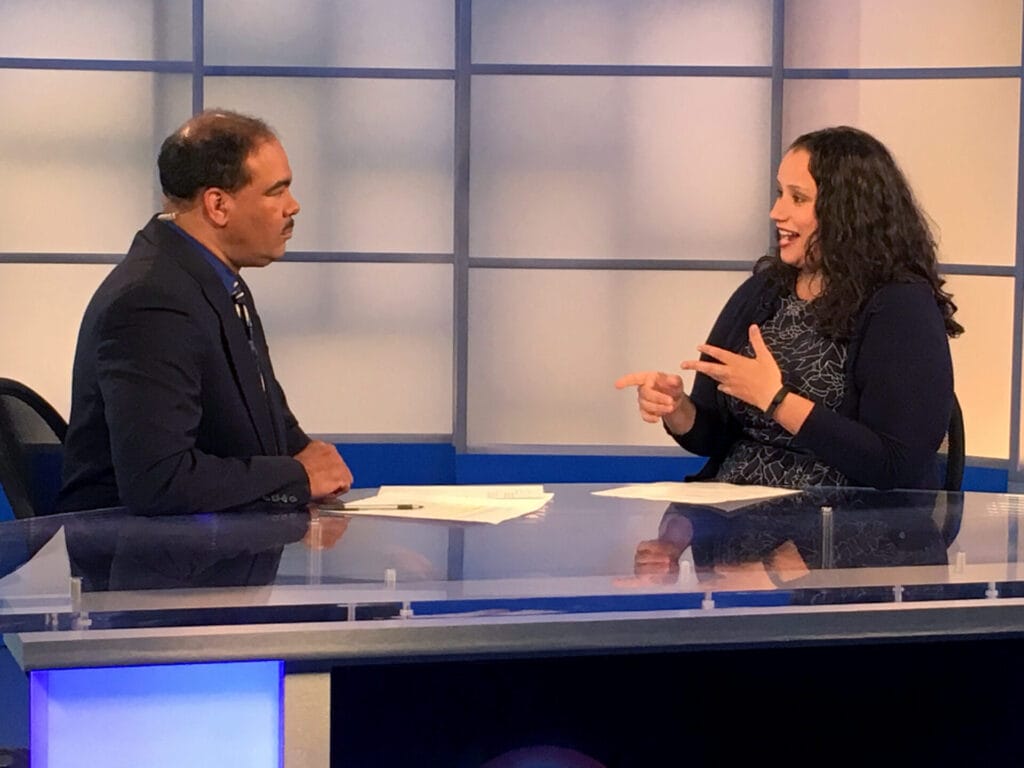English | Spanish

The power and pressure from the in-between identities, sexualities and the journey of self-discovery
Editor’s note: This essay is part of the “Authentic Self” series, which is part of the initiative “More LGBTQIA+ Latinx in Newsrooms.” It aims to share stories and underscore the importance of hiring more queer reporters in newsrooms. The series is a project of the National Association of Hispanic Journalists’ LGBTQIA+ Committee, palabra and GLAAD. Words by Michelle Faust Raghavan (@MicheReports) |
Have you ever heard the all-too-common question “…but where are you really from?” For many children of migrants, the answer is less than clear. “Ni de aquí, ni de allá” translates as “neither from here, nor from there.” Mexican American actor and producer Edward James Olmos described the concept in his role as Selena’s father Abraham Quintanilla in the 1997 film Selena.
“We have to be more Mexican than the Mexicans and more American than the Americans, both at the same time! It’s exhausting!” James Olmos said.
You don’t have to be Mexican American to relate to this line. If your identity has a hyphen in it, the concept rings true.
My identity has always been split. My heritage is Puerto Rican, but I grew up between Oregon and California, far from any large Puerto Rican populations. I’m multiracial, bilingual, bicoastal and bisexual. My identity spans across the binaries of gender and sexual orientation.
‘In the past, my stories have faced extra scrutiny by editors and audiences based on my racial and ethnic backgrounds. I didn’t want to add my LGBTQ identity as more fuel to the fire.’
Like Chicana feminist Gloria Anzaldúa, I straddle a spiritual borderland, existing in constant negotiation of my nuanced identities. There’s power in the in-between. Living in this gray space has helped make me a more empathetic and compassionate person. I use this understanding to better navigate the world, and that worldview transfers to my work.
First and foremost, I’ve always wanted to prove myself as a talented journalist. Being nonbinary and pansexual are part of who I am, but it is not all I bring to the newsroom. I am also a multifaceted strategist, editor, mentor, coach and reporter.
Still, I’ve spent most of my working life afraid that coming out as LGBTQ+ would cost me a career. The reality is that journalists of color are often judged based on their identity before they are seen for their abilities. In the past, my stories have faced extra scrutiny by editors and audiences based on my racial and ethnic backgrounds. I didn’t want to add my LGBTQ identity as more fuel to the fire.

In high school and college, I was pretty open about who I am. However, this changed when I entered the journalism industry. Since I’m perceived as a woman and sometimes date men, I’ve let most colleagues incorrectly assume I’m straight and cisgender. It was simpler that way. One less thing to hold against me.
I tried to come out more than a handful of times after growing close to certain colleagues. Unfortunately, even some of my gay and lesbian coworkers would contradict me or say that bisexuals didn’t exist. Like me, many of my straight work friends are Christians. Although I have made peace with my identity and my relationship with God, I worried they would reject me.
A couple of years ago, I decided that living authentically was more important than the world’s perceptions of me. I publicly embraced they/them (“elle,” in Spanish) pronouns and started experimenting with more androgynous clothing and hairstyles. It’s been a freeing process, but sometimes I still fear for my career. Ultimately, I’ve found relief as I have been able to be more of my complete self.
Even in the face of these barriers, journalism has long been my passion. As a child, I’d sit on the living room floor with my legs crossed watching Kermit the Frog report breaking news on Sesame Street. Shortly after, I started watching the local and national evening news. As the newscasts moved from talking puppets to people, I noticed that few reporters looked like me or my family members. I also noticed that Latine communities were often painted with a broad brush, painted as problematic immigrants without care for the issues we face and the real diversity that makes us who we are.

The Spanish-language news was a little better. There were more stories from Latin America and the reporters were Latine, but I still didn’t see the diversity of skin color on screen that I saw at my family gatherings. My grandmother would sometimes point to the hyper-feminine women anchors and tell me that could be me. I knew that I would never be that thin, stereotypically feminine or, frankly, that good at doing my makeup.
It wasn’t until I decided to study journalism in college that I finally found a journalist who I could truly relate to. I discovered NPR’s Talk of the Nation formerly hosted by Ray Suarez. I loved his voice, how quick he was with facts, and how he could lead a solid and respectful debate on any topic. He was both brilliant and a proud Latino — a Nuyorican (New Yorker of Puerto Rican descent) just like my family. He had the job, the skills and the style that I wanted to grow into down to the suit and tie.
In a multitude of ways no soy ni de aquí, ni de allá and that may be hard for many who have never experienced this in-between feeling to understand. However, I’ve learned that the more that I own it, the more I will shine. Being who I am forces me to explore many aspects of the human experience. This has taught me to listen better, and to ask better questions of myself, the world and others. The multiple facets of who I am only make me a better, more well-rounded journalist.
—
Subscribe to palabra’s newsletter.
Michelle Faust Raghavan is the founder of Claridad Media, a newsroom consulting firm, and is currently researching best practices to improve retention of journalists of color in public media. Michelle is an award-winning journalist, editor, newsroom consultant and a regular managing editor with the Next Generation Radio project. As a policy reporter and radio host in public media member stations around the country, they advanced solutions, service and participatory journalism practices. Michelle is an NAHJ lifetime member and was recently a John S. Knight Journalism Fellow at Stanford.
Tat Bellamy Walker is the communities reporter for the Seattle Times, where he reports on diverse groups throughout the Pacific Northwest. Last year, he reported for NBC News’ diversity verticals (NBC Latino, BLK, OUT and Asian America). In 2021, he was named a Poynter-Koch Media and Journalism Fellow, where he joined more than 50 local journalists from newsrooms across the US. His work has appeared in the Daily Beast, Business Insider and CNN.
Luis Joel Méndez González reports on climate change and disaster recovery for the Center for Investigative Journalism through Report for America since 2022. He is an experienced data-driven and multimedia reporter. Méndez González holds a Masters Degree in Data Visualization and Information Design, and sits on NAHJ´s Board of Directors as General At-Large Officer. He´s also co-chair of the LGBTQIA+ Committee.
David Cordero Mercado is a multimedia and investigative journalist. He has reported on hate crimes in Puerto Rico as a reporter for El Nuevo Día, the biggest newspaper on the island. He earned a master’s degree in Communications with an emphasis in Journalism Innovation from Syracuse University in New York, and a bachelor’s degree in Information and Journalism from the School of Communication of the University of Puerto Rico, Río Piedras Campus, as well as a second concentration in Political Science. He is also the Region 1 Director on the Board of Directors of the National Association of Hispanic Journalists.
“Ni de Aquí, ni de Allá”

El poder y la presión de estar entre múltiples identidades, sexualidades y la travesía del autodescubrimiento
Nota del editor: Este ensayo de la serie “Ser Real” forma parte de la iniciativa “Por más periodistas LGBTQIA+ en las noticias” del Comité LGBTQIA+ de la Asociación Nacional de Periodistas Hispanos, palabra y GLAAD el cual busca compartir las historias y la importancia de contratar a más periodistas queer en los medios de comunicación. En cada ensayo se respetó el criterio personal de cada autor en el uso de lenguaje inclusivo. Reportaje de Michelle Faust Raghavan (@MicheReports) |
¿Has escuchado alguna vez la pregunta tan común: “¿De dónde eres… realmente?” Para muchos hijos de migrantes, la respuesta no es clara. “Ni de aquí, ni de allá” es una frase con la que nos identificamos las personas que no somos parte ni de un lado ni del otro. El actor y productor mexicanoamericano, Edward James Olmos, compartió su definición de esa frase mientras interpretaba a Abraham Quintanilla, padre de Selena Quintanilla, en la película en honor a la célebre artista en 1997.
“Tenemos que ser más mexicanos que los mexicanos y más americanos que los americanos a la misma vez. ¡Es agotador!”, exclamó James Olmos.
En realidad, no necesitas ser mexicanoamericano para sentirte identificado con esa frase. Todas las personas con más de una identidad la pueden entender.
Mi identidad siempre ha estado dividida. Soy de ascendencia puertorriqueña, pero crecí entre Oregón y California — lejos de cualquier otra comunidad boricua en la diáspora. Soy multiracial, bilingüe, bicostere y bisexual. Mi identidad va más allá de cualquier identidad de género y orientación sexual.
‘Mis historias se han enfrentado a un escrutinio mayor de parte de mis editores y lectores solo por mi trasfondo racial y étnico. Por lo tanto, no quería que mi identidad LGBTQIA+ le echara más leña al fuego’.
Así como la feminista chicana Gloria Anzaldúa, me encuentro en una frontera espiritual en la que constantemente negocio con esas identidades que se encuentran interconectadas. Sin embargo, reconozco que hay un poder en estar entre ambas. Vivir en ese espacio gris me ha permitido ser una persona más empática y compasiva. Utilizo este conocimiento para navegar mejor por el mundo y esa visión del mundo se transfiere a mi trabajo.
Desde que tengo memoria, siempre quise demostrar que era une periodista talentose. Aunque ser una persona nobinaria y pansexual es parte de lo que me identifica, no es todo lo que aporto a la sala de redacción. También soy una persona estratégica, edito, reporto y ayudo a periodistas nuevos con mi conocimiento y experiencia.
Aun así, por gran parte de mi vida laboral tuve miedo a salir del closet porque pensaba que ser una persona LGBTQIA+ me costaría mi carrera. De por sí, ya los periodistas de color tendemos a ser juzgados por nuestra identidad. Me ha ocurrido. Mis historias se han enfrentado a un escrutinio mayor de parte de mis editores y lectores solo por mi trasfondo racial y étnico. Por lo tanto, no quería que mi identidad LGBTQIA+ le echara más leña al fuego.

En la escuela superior y en la universidad estaba bastante abierte a quien era. Esto cambió una vez comencé en el periodismo. Ya que a veces me percibían como mujer y a veces salía con hombres, esto permitía a la mayoría de mis colegas asumir que soy heterosexual y cisgénero. Era más sencillo así. Era una cosa menos que podrían usar en mi contra.
Intenté salir del closet en varias ocasiones una vez entraba en confianza con mis colegas. Desafortunadamente algunos de mis compañeros de trabajo, aún siendo homosexuales, ponían en duda mi bisexualidad y decían que tal orientación sexual no existía. Como yo, muchos de mis amigos de trabajo heterosexuales eran cristianos. A pesar de que me encuentro en paz con mi identidad y mi relación con Dios, me preocupaba que me rechazaran.
Hace unos años decidí vivir una vida auténtica y abierta, más importante que la percepción del mundo sobre mí. Públicamente adopté el pronombre elle (they/them, en inglés) y comencé a experimentar con ropa y estilos de cabello más andrógenos. Fue un proceso liberador, pero a veces aún temo por mi carrera. En el fondo, he encontrado alivio puesto que he sido capaz de ser más mí misme.
Recuerdo que, en mi niñez, me sentaba en el suelo de la habitación con mis piernas cruzadas para ver a la rana René presentar las noticias en Plaza Sésamo. Poco después comencé a ver las noticias locales y nacionales de la tarde, pero las reales. Comencé a notar que pocos reporteros lucían como yo o los miembros de mi familia. También percibí que las comunidades latinas eran representadas siempre de la misma forma: inmigrantes problemáticos sin interés por las problemáticas que nos aquejan y la diversidad.

Las noticias en español eran un poco mejores. Habían historias sobre América Latina y los periodistas eran latines, pero aún así no veía la diversidad de colores de piel en la pantalla que veía en mis reuniones familiares. Mi abuela a veces señalaba a las presentadoras híper femeninas y me decía que esas podía ser yo. Sin embargo, yo sabía que jamás podría ser así de delgada, estereotípicamente femenina — ni siquiera tener el talento de maquillarme como ellas.
No fue hasta que decidí estudiar periodismo en la universidad que finalmente encontré a un periodista con el cual realmente me identifiqué. Descubrí a Ray Suarez, quien era locutor del programa Talk of the Nation transmitido a través de NPR. Su voz me encantaba, y también cuán ágil era con los datos y cómo podía liderar un debate respetuoso e incisivo sobre cualquier tema. Era brillante, un orgulloso latino nuyorican — un neoyorkino de ascendencia puertorriqueña como mi familia. Él tenía el trabajo, las destrezas y el estilo el cual quería adoptar, así, con todo traje y corbata.
“No soy ni de aquí, ni de allá”, por un sinnúmero de razones. Tal vez sea difícil de comprender para las personas que nunca han experimentado cómo se siente tener una identidad que nunca está de un lado o del otro. Sin embargo, con el tiempo, he aprendido que entre más abrace esa realidad, más brillaré. Ser quien soy me ha obligado a explorar muchos aspectos de mi como ser humano. Me ha enseñado a escuchar y a preguntar sobre mí y el mundo de mejor manera. Y es que las múltiples facetas de quien soy, no solo me hacen mejor, sino une periodista más complete.
—
Suscríbete al boletín de noticias de palabra.
Michelle Faust Raghavan es le fundadore de Claridad Media, una firma de consultoría para las salas de redacción, y actualmente está investigando las mejores prácticas para mejorar la retención de periodistas de color en los medios públicos. Michelle es une periodista, editore, consultore y editore habitual para el proyecto Next Generation Radio. Como reportere y locutore de radio en los medios públicos en los estados unidos, promovió soluciones, servicios y prácticas de periodismo participativo. Michelle es lifetime member NAHJ y recientemente fue becaria del programa John S. Knight de periodismo en Stanford.
Tat Bellamy-Walker es reportero para el Seattle Times. He reportado sobre temas de comunidades diversas para medios de comunicación como NBC. En 2021 fue nombrado Poynter-Koch Media and Journalism Fellow, donde se unió a periodistas de más de 50 redacciones a lo largo de Estados Unidos. Su trabajo ha aparecido en Daily Beast, Business Insider y CNN.
Luis Joel Méndez González es un periodista especializado en temas de cambio climático y recuperación en el Centro de Periodismo Investigativo a través de Report for America desde 2022. Se graduó con una maestría en Visualización de Datos y Diseño de Información de la Universidad de Northeastern y un bachillerato en Tele-Comunicación Radial de la Universidad de Puerto Rico en Arecibo. Forma parte de la Junta de Directores de la NAHJ en carácter de General At-Large Officer. Es integrante del Comité LGBTQIA+ de NAHJ.
David Cordero Mercado es un periodista multimedia e investigativo. Ha reportado sobre crímenes de odio en Puerto Rico contra las comunidades LGBTQIA+ como reportero para El Nuevo Día. Obtuvo una maestría en Comunicaciones de la Universidad de Syracuse en Nueva York y un bachillerato en Información y Periodismo de la Universidad de Puerto Rico, Recinto de Río Piedras. También es el Director de la Región 1 de la Junta de Directores de NAHJ.












